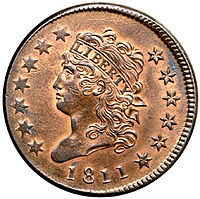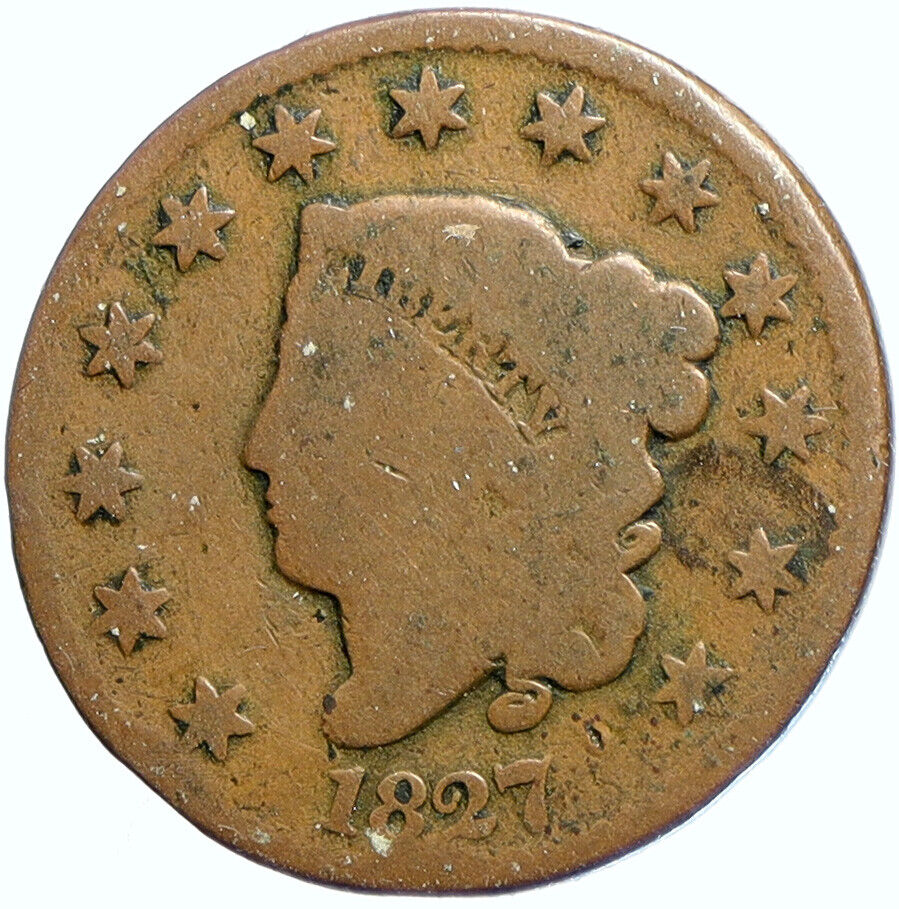|
United States of America
Large Cent
28mm (10.17 grams)
1837, Head of Liberty left with 13 six-pointed stars around.
UNITED STATES OF AMERICA, ONE CENT within wreath.
You are bidding on the exact
item pictured, provided with a Certificate of Authenticity and Lifetime
Guarantee of Authenticity.
The
United States
large cent was a
coin with a
face value
of 1/100 of a
United States dollar
. Its diameter varied
between 27mm and 29mm. The first official mintage of the large cent was in 1793,
and its production continued until 1857, when it was officially replaced by the
modern-size one-cent coin
(commonly called the
penny
).
Large cents were made of nearly pure copper, or copper as pure as it emerged
from smelting, without any deliberate addition of other metals (such as occurs
in bronze
).
General history
First struck in 1793, the large cent was coined every year from 1793 to 1857
(with the exception of 1815, due to a shortage of copper). The Philadelphia Mint
produced all large cents, which contained twice the copper of the
half cent
. This made the coins bulky and heavy,
bigger than modern-day
U.S. Quarters
.
Flowing Hair cents, chain reverse (1793)
Main article:
Chain cent
Henry Voigt
‘s design was almost universally
criticized in its time for its unattractiveness and perceived allusion to
slavery. It bears the distinction, however, of being the first official coinage
minted by the United States federal government on its own equipment and
premises. 36,103 were minted. Its low survival rate, in addition to its small
mintage, coupled with being the first regular federal issue and a one-year
design and type, has created an extremely strong demand from generations of
numismatists. As a result, all surviving specimens command high prices ranging
from $2,000-$3,000 in the absolute lowest state of preservation to over $500,000
in the highest.
Flowing Hair cents, wreath reverse (1793)
Main article:
Wreath cent
The Mint caved in to the intense ridicule later in 1793, and Mint Director
David Rittenhouse
ordered
Adam Eckfeldt
to revise the obverse and reverse
designs. Liberty’s bust was redesigned with even longer, wilder hair, and the
chain was removed from the reverse in favor of a wreath. Scholars are undecided
as to what plant or plants are depicted in the wreath, with several varieties
extant. Total mintage of the wreath reverse numbered about 63,000 pieces.
Liberty Cap cents (1793–1797)
Main article:
Liberty Cap Large Cent

An 1811 Classic Head large cent
Rittenhouse was dissatisfied with Eckfeldt’s designs, and with the criticism
of the Chain cents fresh in his mind, he hired
Joseph Wright
to do yet another redesign in the
denomination’s troubled first year. Wright’s design faced Liberty to the right
and “tamed” her wild hair. The
Phrygian cap
was added as an ancient symbol of
freedom. The reverse design was revised to a recognizable laurel wreath, and
future Chief Engraver
Robert Scot
had a hand in several minor
revisions to the design over the next three years.
This design was more successful and it was continued into 1796. In 1795,
planchets
became too thin for the edge
lettering because of a weight reduction, so the mint stopped edge lettering on
the cent, and the rest of these coins were made with a plain edge. Four coins
from 1795 are known to have a reeded edge.
Draped Bust cents (1796–1808)
Main article:
Draped bust
Robert Scot redesigned the whole of United States coinage for 1796, applying
a new design featuring a bust of Liberty wearing a drapery at the neckline and a
ribbon in her flowing hair. The reverse design now featured an olive wreath. As
with earlier types, several minor revisions to the design were made in the first
few years, with the final 1797 design lasting through the end of the type in
1807.
Classic Head cents (1808–1814)
Main article:
Classic Head
John Reich
, assistant to Chief Engraver Scot,
was appointed by new Mint Director
Robert Patterson
to redesign Scot’s Draped Bust
cent (along with every other circulating coin design). The so-called “Classic
Head” derives its name from the
fillet
worn by Liberty on the obverse, though
the fillet was worn only by male athletes in ancient Greece. The copper used
during the years in which Classic Head cents were minted was of a higher
quality, containing less metallic impurity. Consequently, they were softer and
more prone to wear and corrode more quickly than issues before or after. As a
result, unimpaired, high-grade specimens are especially difficult to obtain and
fetch strong premiums when they appear on market, especially with original red
or red-brown mint luster.
Coronet
cents (1816–1857)
Main article:
Matron Head

An 1850 Braided Hair cent
Matron Head, or Middle Dates (1816–1839)
As a response to public criticism of the Classic Head, the Mint assigned
Chief Engraver Scot to redesign the cent in 1816. This newest design enlarged
the obverse portrait, giving Liberty a much more mature look (leading to the
Matron Head reference), and surrounded the portrait with stars along the outer
edge of the coin. The “Matron head” design was modified in 1835 to give Liberty
a younger look and matron head cents continued to be made until 1839.
Braided Hair, or Late Dates (1839–1857)
Facing more negative public reaction, the Coronet cents were redesigned in
1835 by new Chief Engraver
Christian Gobrecht
. This last major change to
the coin updated the obverse by giving Liberty a slimmer, more youthful
appearance. Minor tweaks continued through 1843, and the 1843 design prevailed
through the end of mintage in 1857. Some 11 years after the large cent was
discontinued, a mint employee coined several large cents dated 1868, almost
certainly for sale as instant rarities to numismatists. Fewer than a dozen of
these unofficial issues, struck in both bronze and copper-nickel, are known to
survive.
See also
-
Cent (United States coin)
-
United States dollar
-
Mill (currency)
|










